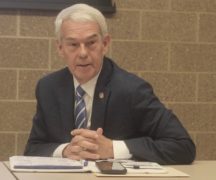By JAN LARSON McLAUGHLIN
BG Independent News
As chancellor of higher education for Ohio, Randy Gardner no longer has to spend his weekends eating at chicken barbecues, riding in parades, and attending festivals.
But Gardner is approaching his new job much the same way as he did when he took his first term as state representative for Wood County in 1985.
He promptly made visits to all 26 municipalities and 19 townships in the county. Many of the small town mayors and township trustees said they had never before been visited by their state representative.
Thirty-five years and 10,453 legislative votes later, Gardner has now visited 74 of the more than 100 college campuses in Ohio.
And like his early legislative career, many of the smaller college officials said they had never received a call from the chancellor of higher education – let alone had a visit.
“I’ve always believed if you get paid by taxpayers, you owe the public all you’ve got,” Gardner said Thursday as he gave an update on his new position to the Bowling Green Kiwanis Club.
Gardner talked about college tuition, student loans, job opportunities, and the need for teachers.
Parents and students are benefitting from Ohio’s “tuition guarantee,” which requires all state universities to charge the same tuition for four years – from freshman and senior years.
“Parents appreciate the transparency and predictability,” he said.
A decade ago, the average tuition in Ohio was 150% of the national average. Now, the overall growth in tuition in Ohio is the lowest in the nation, Gardner said.
Ohio has gone from an exporter of students to an importer of students from other states, due to price and quality of college educations, he said.
The diversity of opportunities is great, with Ohio having some of the best trade apprenticeship programs, Gardner said.
The state must offer an “all of the above approach” in education.
“We cannot afford to have turf battles when it comes to education,” he said.
Gardner believes parents and students must be made aware of the educational options, tuition costs, and prospective job opportunities.
“I believe we owe young people and their families all the information we know,” he said.
As for student loans, Gardner said the number of students in Ohio taking out loans has dropped for seven consecutive years.
“But student debt overall is still going up,” he said.
Approximately 7% of the borrowers owe $100,000 or more. But it’s those who owe less than $5,000 who are most likely to default. Many of those people never completed their degrees, and never got the occupations they had intended to reach.
The level of college loan debt has had a negative effect on housing and other growth, as many young adults put off raising families and buying their first homes.
“The older debt has been a real hamstring on families,” Gardner said.
An estimated 1.5 million Ohioans have some college credits, but never got their degrees. Another 800,000 have no high school diploma or GED.
So Ohio is working to get those people to go back to school.
Gardner also talked about the declining number of students going into teaching careers. Many are under the impression that they can’t make a good living as an educator. That isn’t true, he said, citing the average secondary teacher salary in Ohio as $61,930.
“Some people believe a teaching profession isn’t worthy of providing for a family,” he said.
“Teaching is one of the most valuable, important professions someone can do.”



